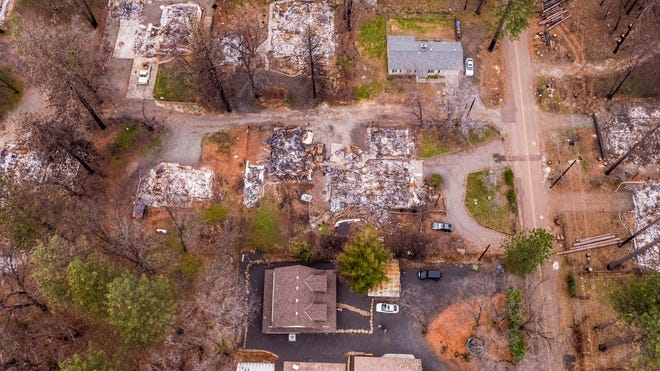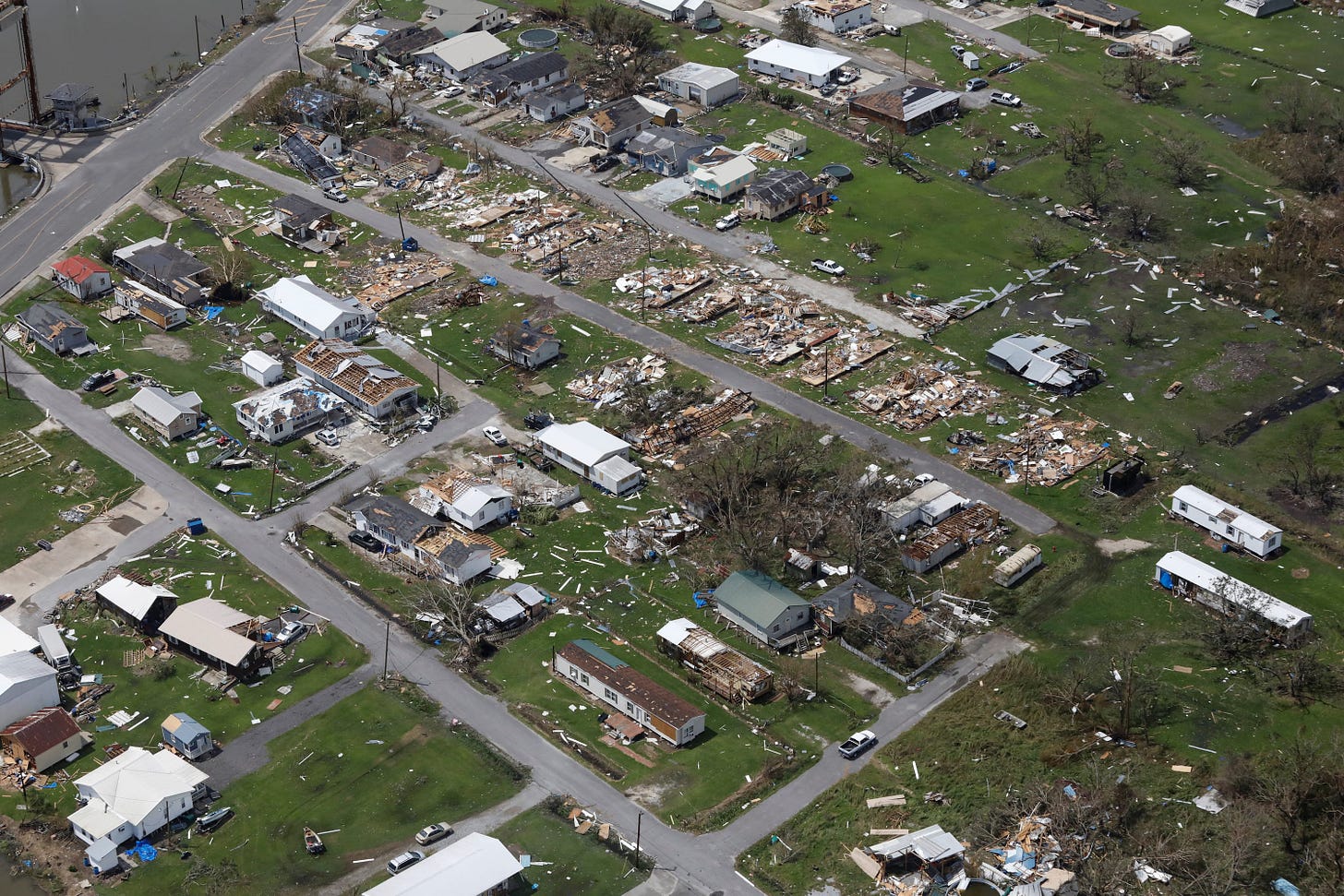Climate disasters reveal truths we usually can't see
Climate change-fueled extreme weather events highlight overlooked dangers
Warren Buffet has a classic line that’s as insightful as it is vivid:
It’s only when the tide goes out that you discover who’s been swimming naked.
He means that when markets are rising many investment funds show high returns, and it’s only when markets eventually fall that you find out which funds’ returns were safe and sustainable, and which were artificially fueled by risky leverage. Funds in the latter group usually crash.
I thought of the line once while looking at photos of devastation following a natural disaster and noticed that while many homes were destroyed, others appeared mostly intact. It turns out this is a common pattern. We saw it, for example, in Florida in the aftermath of Hurricane Ian in 2022:
We saw it in the town of Paradise, California after the 2018 Camp Fire:
And we saw it in Louisiana after Hurricane Ida in 2021:
One question I have is to what extent are post-disaster differential destruction patterns knowable a priori? We can stipulate that if an engineer knew the specs, materials, age, upkeep, and so on for each structure, she could make a strong educated guess which would survive and which wouldn’t. But what about just a regular resident of the neighborhood? Could he tell by looking at his neighbors’ homes which were likely to remain whole in the face of a hurricane and which weren’t? I think the answer is “To some degree, yes, depending on the types of structures and how knowledgable and observant the person is, but nowhere close to perfectly.” But that’s just a guess.
One question worth asking is whether the differential destruction of homes is a problem we should be trying to address.
While there may be various reasons the destroyed buildings weren’t as resilient or durable as the ones that survived, in most cases it’s simply that they were built with lesser materials and construction methods that were chosen because they’re cheaper. This is a familiar tradeoff in life. Lower priced goods cost less precisely because they’re lower quality. In exchange for assuming the risks and other downsides of a lower quality home, buyers receive a set of benefits that includes the home itself and the money they didn’t have to spend on a higher quality, more expensive home.
It’s likely, though, that many buyers made these judgments and chose their homes without fully understanding the implications. Engineers and builders know the risks associated with lower quality home construction, but buyers may not. Most will tend to focus on cost, space, location, appearance, and the other criteria people care about when choosing a home.
Most people who buy lower quality homes also probably can’t afford a more durable, higher quality home,1 so the lower quality option is more a default than a choice. They want to buy a home and the less durable options are the ones they can afford.
But given the differential structural damage caused by climate-fueled weather events, should we as a society tolerate the same price-quality tradeoff in homes, which people rely on for physical safety (among other things), that exists for televisions, drill bits, and other less consequential goods? The truth is we already have safety requirements for houses (building codes) and for other goods and services (product safety laws). These regulations constrain the extent of the tradeoff consumers can make between price and quality. These protections ensure a certain level of safety for consumers, and we pay for it in the form of somewhat more expensive goods and homes. We could have lower prices if we lowered safety standards and tolerated higher risks, but, as of today, we’ve collectively decided to insist on - and pay for - a wide range of basic safety standards in products, houses, etc.
Maybe the right question, then, is whether we should raise the minimum level of home construction quality in light of increasing physical risks from climate change. Reasonable question, though if the answer seems obvious, it probably shouldn’t. Doing this would increase the cost of the least expensive homes (because they’re the least safe), which will put them out of reach for a tranche of people struggling economically. And this increase would be on top of the sharp overall rise in home prices in recent years. We might nevertheless decide to raise construction quality standards so fewer people’s homes are destroyed by the climate-intensified storms of the coming decades. It’s a very defensible idea, especially since people aren’t great at factoring long-term concerns into current decisions (this is the core logic behind Social Security). It might be the right call. But we shouldn’t make it without being lucid about the painful tradeoffs involved.
There are a lot of directions one might go with this observation about the differential impacts of disasters on neighboring homes. These are a few of the thoughts that come to mind for me:
In economic terms, there’s a large information asymmetry between builders and buyers. There’s always a public policy argument to try to close information asymmetries, which tend to lead to economically inefficient outcomes. Here, that argument grows more compelling as physical risks increase due to climate change. Among other things, greater disclosure requirements could emerge as the middle-ground position between increasing construction standards and doing nothing at all.
The deeper we move into the climate era, the greater the value of the ability to see what’s around us - clearly and fully - before it’s revealed by a natural disaster, not just after. I’m drawn to this idea because it’s something I’ve been doing for a few years now, a habit and skill I’m already well into developing and always working to refine with new information, insights, and expertise.
One lens on this issue of differential destruction of structures is the tradeoff between efficiency and resilience.2 Cheaply built, inexpensive homes are efficient in the sense that they serve a very valuable function, as a home, and do so with limited resources. More concretely, every home can be thought of as having a utility-to-cost ratio - how useful it is compared to how much money it takes to create it - and an inexpensive home that a family can live in year round has a high utility:cost ratio. In other words, it’s very efficient. But as we sometimes discover painfully in the aftermath of big storms, these homes have limited resilience. When the physical conditions change too much, these homes fail. A home built more durably costs more and is therefore less efficient. But it can survive more extreme conditions, which makes it more resilient. What makes the efficiency/resilience analytical framework especially cool is its versatility; it works as well at the level of the global economy as it does at the level of a single home. For many decades after WWII, and accelerating after the collapse of the Soviet Union, the world built a globalized economy in which companies’ optimized for efficiency. This made sense in a world where we could reasonably expect relative stability, and that assumption generally held true from the 1950s until recently. But it’s been called into question lately by, among other things: climate change, the Covid19 pandemic, Russia’s war on Ukraine, the Israel-Hamas war, the Houthi attacks on commercial shipping vessels in the Red Sea, and more. So far, our built-for-efficiency global economy has held up fairly well, but if we are in an era of destabilization more severe stress tests will surely come. Rather than waiting for them, we should think about whether and where we’re willing to sacrifice some efficiency in exchange for greater resilience (the Biden administration’s supply chain re-shoring and near-shoring efforts are partly about exactly this issue).
What do you think about all of this? If you have a thought, drop a note in the comments, I’d love to hear it.
That more durable homes are too expensive for many people is among the more physically dangerous ways that climate change exacerbates inequality.
After years of wondering, I just googled “resilience vs. resiliency” and it turns out you can use either one and they’re more or less exactly the same.








Mr. Fletcher, what you are ably discussing is the incentive structure. I live in Florida.
After hurricane Andrew devastated parts of Miami in 1992, the state legislature adopted the "Miami-Dade Building Codes," but only for parts of Florida, in 2002. Following this, the legislature succumbed to the will of the construction lobbyists in 2017, and continues to do so.
https://www.wunderground.com/cat6/South-Floridas-Hurricane-Building-Code-StrongAnd-North-Floridas-Could-Be-Stronger
The incentive structure behind our official building codes is a mess (but so is the incentive structure behind almost all of our politics). What we need is several smart legislators who can figure out a way to incentivize builders and insurance companies into building new homes, and hardening older homes, to make them less susceptible to climate change.